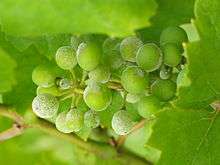oidium
English

Grapes affected by Erysiphe necator
Etymology
From Late Latin ōidium, from Ancient Greek ᾠόν (ōión, “egg”) + -ium
Noun
oidium (plural oidia)
- A fragile spore produced by some fungi.
- 2003 August, Competition Science Vision, page 802,
- • Oidia are hyaline, small and thin-walled unicellular sections or fragments of the mycelium.
- • Oidia may be uni- or binucleate as whether they are produced by the breaking up of the primary or secondary mycelium.
- 2004, P.D. Sharma, The Fungi, page 241,
- However, in some forms mainly some Hymenomycetes it occurs by the formation of oidia. The oidia are of two main types.
- 2006, A. V. S. S. Sambamurty, A Textbook of Plant Pathology, page 239,
- Later the pods become covered completely with white powdery mass composed of mycelium, oidiophores and oidia of the fungus.
- 2003 August, Competition Science Vision, page 802,
- The fungus Erysiphe necator (= Uncinula necator), which produces powdery mildew in grapes.
Coordinate terms
Related terms
- oidial
- oidiophore
This article is issued from
Wiktionary.
The text is licensed under Creative
Commons - Attribution - Sharealike.
Additional terms may apply for the media files.